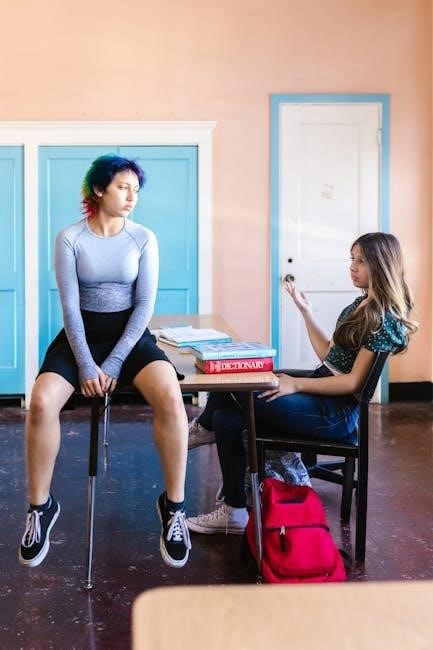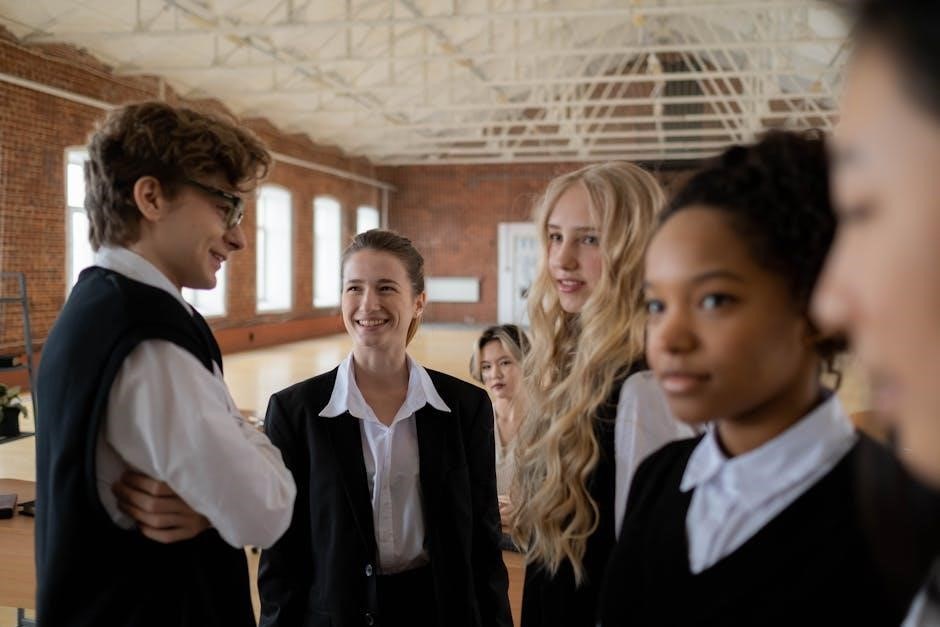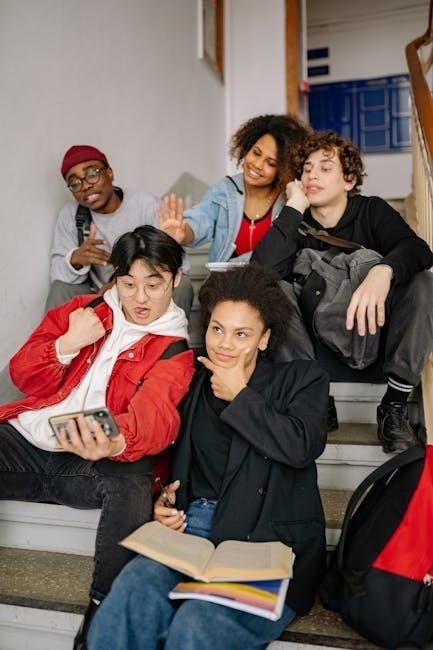Ice breakers are engaging activities designed to help high school students connect‚ reduce anxiety‚ and create a welcoming environment. They foster communication‚ teamwork‚ and mutual understanding‚ making them essential for building a positive classroom or social dynamic. By encouraging participation and creativity‚ ice breakers set the stage for meaningful interactions and lasting relationships among students.
What Are Ice Breakers and Their Purpose
Ice breakers are activities or questions designed to help individuals overcome initial hesitations and connect with others in a group setting. Their primary purpose is to foster engagement‚ encourage communication‚ and create a relaxed atmosphere‚ making it easier for high school students to interact. These activities are particularly useful at the beginning of a gathering‚ class‚ or event to break down barriers and establish a sense of camaraderie. By promoting participation and interaction‚ ice breakers lay the foundation for a more collaborative and inclusive group dynamic.
Why Ice Breakers Are Important for High School Students
Ice breakers are essential for high school students as they help ease social interactions and reduce initial anxiety in new or unfamiliar group settings. These activities foster inclusivity‚ encouraging even the shyest students to participate and feel valued. By promoting teamwork and collaboration‚ ice breakers help students develop essential social and communication skills. They also create a sense of belonging‚ which is crucial during adolescence. Additionally‚ ice breakers prepare students for real-world interactions‚ teaching them how to engage confidently in diverse social and professional environments. They lay the groundwork for a supportive and connected community.
Popular Ice Breaker Games for High School Students
Games like Human Bingo‚ The Name Game‚ and Two Truths and a Lie are popular icebreakers that promote interaction‚ laughter‚ and bonding among students.
Human Bingo: A Fun and Interactive Game
Human Bingo is a lively activity where students create bingo cards with unique traits or questions. They mingle to find peers matching each description‚ fostering conversations and connections. This game encourages students to step out of their comfort zones‚ promoting teamwork and social interaction. It’s an excellent way to break the ice‚ helping students discover common interests and build friendships in a dynamic and engaging manner.
The Name Game: Helping Students Remember Each Other
The Name Game is a classic icebreaker that helps students learn and remember each other’s names. Participants sit in a circle‚ introducing themselves with an adjective starting with the same letter as their name. For example‚ “Happy Hannah” or “Creative Chris.” This activity not only makes names stick but also adds a fun‚ personal touch. It encourages active listening and engagement‚ creating a relaxed atmosphere where students feel comfortable interacting with one another. Variations include acting out adjectives or sharing a hobby‚ making it adaptable for different group sizes and settings.
Two Truths and a Lie: Encouraging Creativity and Laughter
Two Truths and a Lie is a lively icebreaker where students share two true statements and one false statement about themselves. Peers then guess which one is the lie‚ sparking laughter and curiosity. This activity fosters creativity and encourages students to think outside the box. It’s an excellent way to break the ice‚ promote interaction‚ and help students get to know each other in a fun and engaging manner. The game’s simplicity makes it a crowd favorite‚ suitable for various group settings and age levels.
Team-Building Activities for High School Students
Team-building activities are designed to foster collaboration‚ problem-solving‚ and trust among students. These exercises encourage unity‚ creativity‚ and mutual respect‚ helping students work together effectively. They are engaging‚ challenging‚ and fun‚ making them ideal for high school environments to strengthen bonds and prepare students for real-world teamwork.
The Human Knot: A Classic Team-Building Exercise
The Human Knot is a timeless team-building activity where students stand in a circle‚ reach across‚ and grab hands with two different people. The goal is to untangle themselves without letting go‚ fostering communication‚ trust‚ and collaboration. This exercise encourages problem-solving and teamwork while breaking down barriers. It’s simple yet effective‚ helping high school students bond and learn to rely on each other. The activity promotes unity and mutual respect‚ making it a popular choice for ice-breaking and team development in educational settings.
Scavenger Hunts: Promoting Collaboration and Problem-Solving
Scavenger hunts are dynamic and versatile activities that promote collaboration and problem-solving among high school students. By creating a list of challenges or items to find‚ students work together to achieve common goals‚ fostering teamwork and communication. These hunts often include riddles‚ puzzles‚ or creative tasks that require critical thinking and mutual support. Whether conducted in-person or virtually‚ scavenger hunts adapt to various settings‚ encouraging students to bond while developing essential skills. They not only break the ice but also build lasting connections and a sense of camaraderie.

Ice Breakers for Public Speaking and Confidence
Ice breakers tailored for public speaking and confidence help students express themselves comfortably. Activities like “Would You Rather” and “If I Could” prompt thoughtful discussions‚ fostering confidence and reducing nervousness among high schoolers.
Would You Rather: Engaging Students in Thoughtful Discussions
“Would You Rather” is a dynamic ice breaker that sparks creative thinking and conversation. Students are presented with challenging choices‚ such as “Would you rather travel anywhere or learn any skill?” This activity encourages them to share their preferences‚ explaining their reasoning. It fosters confidence‚ public speaking skills‚ and teamwork while revealing unique personalities. The engaging nature of the questions helps students connect on a deeper level‚ making it an excellent tool for building classroom rapport and fostering a supportive environment for open expression.
If I Could: Encouraging Students to Share Their Dreams
“If I Could” is a powerful ice breaker that invites students to share their aspirations and passions. By completing statements like “If I could travel anywhere” or “If I could invent something‚” students open up about their goals and interests. This activity not only fosters self-expression but also helps classmates gain insight into each other’s ambitions. It creates a supportive atmosphere where students feel comfortable sharing their dreams‚ fostering empathy and connection. This simple yet meaningful exercise encourages personal reflection and builds a sense of community within the group.
Virtual Ice Breakers for Online Learning
Virtual ice breakers are essential for engaging high school students in online classrooms. Activities like online name games and virtual scavenger hunts foster connection and reduce anxiety‚ making digital learning environments more interactive and inclusive for all participants.
Online Name Games: Adapting Traditional Activities for Virtual Settings
Online name games are a fantastic way to adapt traditional ice breakers for virtual learning environments. Students can participate in activities like guessing each other’s names based on clues or sharing an adjective that starts with their name’s first letter. These games encourage interaction‚ help students remember names‚ and create a sense of community. By using video conferencing tools or chat features‚ educators can easily facilitate these activities‚ ensuring all students feel included and engaged‚ even in remote settings. This approach fosters connections and makes virtual classrooms more dynamic and inclusive.
Virtual Two Truths and a Lie: Keeping the Fun Alive Online
Virtual Two Truths and a Lie is a engaging online ice breaker where students present two true statements and one false statement about themselves. Peers then guess which one is the lie. This activity can be conducted via video conferencing tools‚ with students sharing their statements aloud or through chat. It encourages creativity‚ laughter‚ and quick thinking while helping students learn interesting facts about each other. The virtual format ensures everyone participates‚ making it an excellent way to build connections in online classrooms or remote group settings.

Creative Ice Breakers for High School Students
Creative ice breakers inspire students to express themselves uniquely‚ fostering connections through art‚ music‚ or imaginative games. These activities encourage self-expression and teamwork‚ making them memorable and engaging.
Art-Based Ice Breakers: Using Creativity to Connect
Art-based ice breakers foster creativity and connection among high school students. Activities like collaborative murals or individual sketches allow students to express themselves‚ share ideas‚ and bond over artistic interpretations. These exercises encourage teamwork‚ reduce shyness‚ and provide a visual representation of collective creativity‚ making them a dynamic way to build relationships and inspire dialogue in a relaxed setting.
Music-Based Ice Breakers: Sharing Favorite Songs and Genres
Music-based ice breakers are a vibrant way to connect high school students through shared musical interests. Activities like creating playlists‚ guessing song titles‚ or discussing favorite genres encourage students to open up about their tastes; These exercises foster conversation‚ reveal common interests‚ and create a relaxed atmosphere‚ helping students bond over the universal language of music while discovering new sounds and genres.

Creating a Safe Environment for Ice Breakers
Fostering inclusivity and respect is crucial for ice breakers. Ensure all students feel valued by encouraging open communication and setting clear guidelines‚ creating a comfortable space for interaction and connection.
Ensuring Inclusivity in Ice Breaker Activities
Inclusivity is vital to ensure all students feel valued. Activities should accommodate diverse backgrounds‚ cultures‚ and abilities. Avoid potentially sensitive topics and use open-ended questions to encourage participation. Provide options for students who may feel anxious‚ such as pairing them with a partner or allowing written responses. Create a safe space where every student’s voice is heard‚ fostering a sense of belonging and respect. This approach ensures ice breakers are enjoyable and beneficial for everyone involved.
Handling Shyness and Anxiety During Ice Breakers
Shyness and anxiety can hinder participation in ice breakers. To address this‚ create a supportive environment by pairing students with partners or allowing written responses. Offer low-stakes activities that don’t force students into the spotlight. Encourage gradual participation and ensure no one feels pressured to share more than they’re comfortable with. Provide reassurance and emphasize that it’s okay to take time opening up. A patient and understanding approach helps students feel safe and included‚ gradually building their confidence to engage.

Designing Your Own Ice Breaker Activities
Creating unique ice breakers involves identifying goals‚ considering student interests‚ and incorporating fun‚ engaging elements. Focus on simplicity‚ creativity‚ and ensuring activities are non-intimidating and inclusive for all participants.
Tips for Creating Effective Ice Breakers
Effective ice breakers should be simple‚ engaging‚ and non-intimidating. Focus on activities that encourage participation without pressure. Personalize them to align with students’ interests and ages‚ ensuring inclusivity. Use clear instructions and keep activities brief to maintain focus. Incorporate creativity‚ humor‚ and movement to keep students engaged. Consider the group size and setting‚ adapting activities to fit the environment. Finally‚ debrief after the activity to reinforce connections and reflections‚ ensuring a meaningful and lasting impact on group dynamics.
Assessing the Effectiveness of Ice Breakers
Evaluating ice breakers involves observing student engagement and interactions. Look for increased participation‚ smiles‚ and voluntary contributions. Use feedback tools like surveys or group discussions to gauge comfort levels and perceived benefits. Compare pre- and post-activity behavior to measure confidence and collaboration improvements. Pay attention to how well students connect afterward‚ as this reflects the activity’s success. Effective ice breakers leave students feeling more comfortable and eager to interact‚ fostering a positive and inclusive environment for further learning and teamwork.
Ice breakers are invaluable for fostering connections‚ reducing anxiety‚ and creating a supportive environment among high school students‚ ensuring a positive foundation for social and academic growth.
Final Thoughts on the Importance of Ice Breakers
Ice breakers are transformative tools for fostering connections‚ easing anxiety‚ and creating inclusive environments. They empower high school students to express themselves‚ build trust‚ and collaborate effectively. By encouraging open communication and creativity‚ these activities lay the foundation for positive relationships and a supportive community. Regular use of ice breakers ensures students feel valued‚ heard‚ and prepared to thrive academically and socially. Educators and leaders should embrace these activities as essential components of a dynamic and engaging learning experience.
